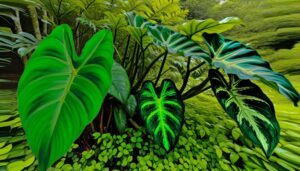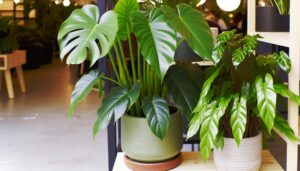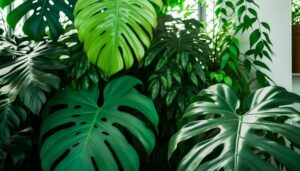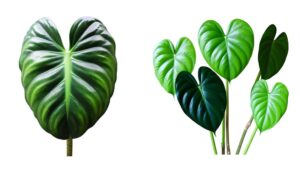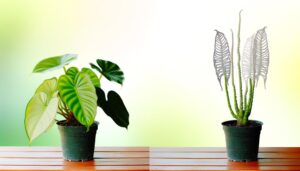Philodendron Brasil Vs Pothos: Key Differences!
Philodendron Brasil and Pothos originate from tropical regions, boasting distinct differences in leaf morphology and care requirements. Philodendron Brasil features heart-shaped, thinner leaves with lime-green streaks, while Pothos has broader, ovate leaves with glossy, creamy-yellow or white variegation.
Their growth patterns also vary; Philodendron Brasil typically has shorter vines, reaching 8-10 feet, whereas Pothos can extend up to 20-30 feet. Both thrive in bright, indirect light, although Pothos is more adaptable to low-light conditions.
Propagation involves stem cuttings, and both are toxic to pets. For those seeking deeper insights into their care and uses, additional specificities await.
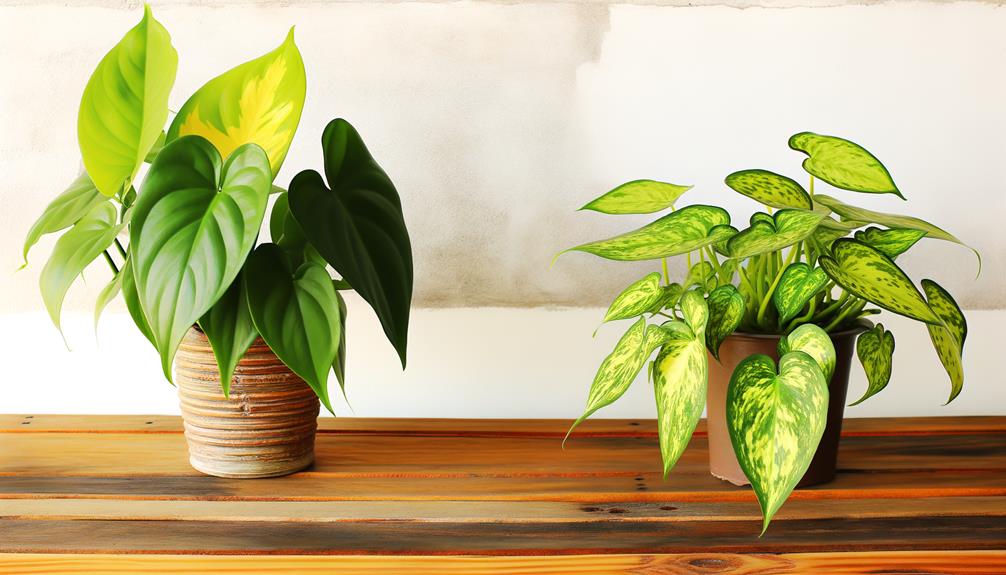
Philodendron Brasil Vs Pothos: Key Differences
| Characteristics | Philodendron Brasil | Pothos |
|---|---|---|
| Leaf Shape | Heart-shaped leaves with a smooth texture | Spade-shaped leaves with a waxy, bumpy texture |
| Leaf Color | Green with yellow variegation | Green with white, gold, or yellow variegation |
| New Growth | New leaves emerge from cataphylls | New leaves unfurl from the previous leaf |
| Petioles | Smooth and round, lighter than the foliage | Grooved ridge, same color as the foliage |
| Aerial Roots | Several smaller aerial roots per node | One large aerial root per node |
| Growth Habit | Climbing, with new leaves growing on small vines | Climbing, with new leaves unfurling from older growth |
| Light Requirements | Tolerates lower light, avoid direct sunlight | Prefers brighter light, can tolerate some direct sunlight |
| Watering | Requires more frequent watering | More drought-tolerant, needs less frequent watering |
| Temperature | Thrives in warm temperatures, avoid cold drafts | Prefers higher temperatures, can tolerate mild direct sunlight |
Origins and Natural Habitat
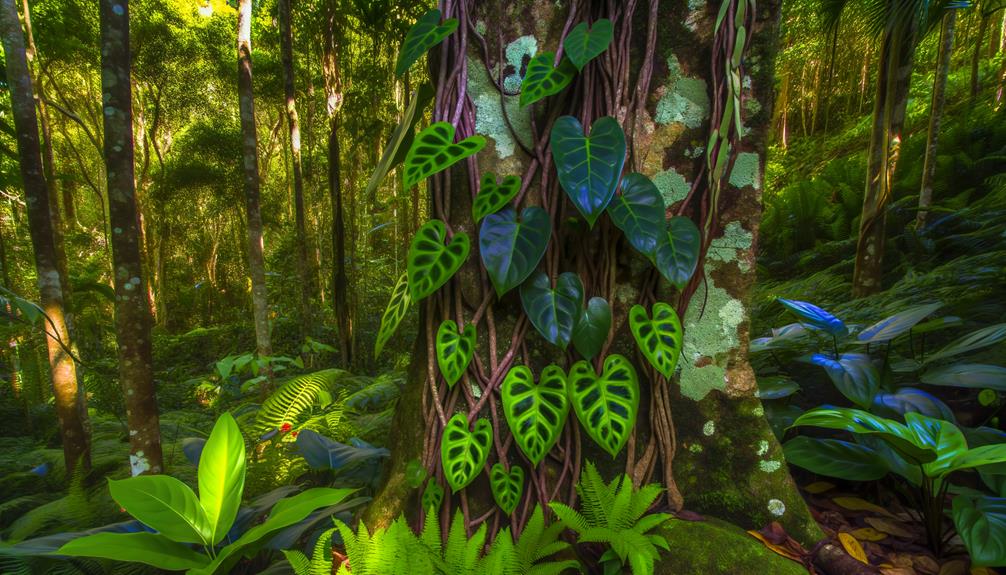
The Philodendron Brasil, a cultivar of Philodendron hederaceum, and the Pothos, belonging to the Epipremnum aureum species, both originate from tropical regions, where they thrive in humid, forested environments.
These plants are indigenous to the rainforests of Central and South America, as well as Southeast Asia. Their natural habitats are characterized by high humidity, consistent rainfall, and dappled sunlight, providing ideal conditions for their growth.
Both species are epiphytic, meaning they often grow on other plants or surfaces, deriving moisture and nutrients from the air and surrounding debris. This adaptability allows them to colonize a variety of ecological niches, from the forest floor to the canopy, showcasing their resilience and versatility in tropical ecosystems.
Leaf Shape and Size
Philodendron Brasil and Pothos exhibit distinct variations in leaf morphology and dimensions, which serve as key identifiers for these species.
Philodendron Brasil typically features heart-shaped leaves with a more pronounced, elongated apex, giving them a more acute appearance. The leaves are generally thinner and softer compared to those of Pothos.
Conversely, Pothos leaves are broader and more ovate, presenting a more rounded base and a blunter tip. The foliage of Pothos is also thicker and glossier, often exhibiting a more robust texture.
Leaf size in Philodendron Brasil ranges from 3 to 5 inches in length, while Pothos leaves can grow larger, often reaching up to 12 inches. These morphological distinctions are critical for accurate species identification.
Color and Variegation
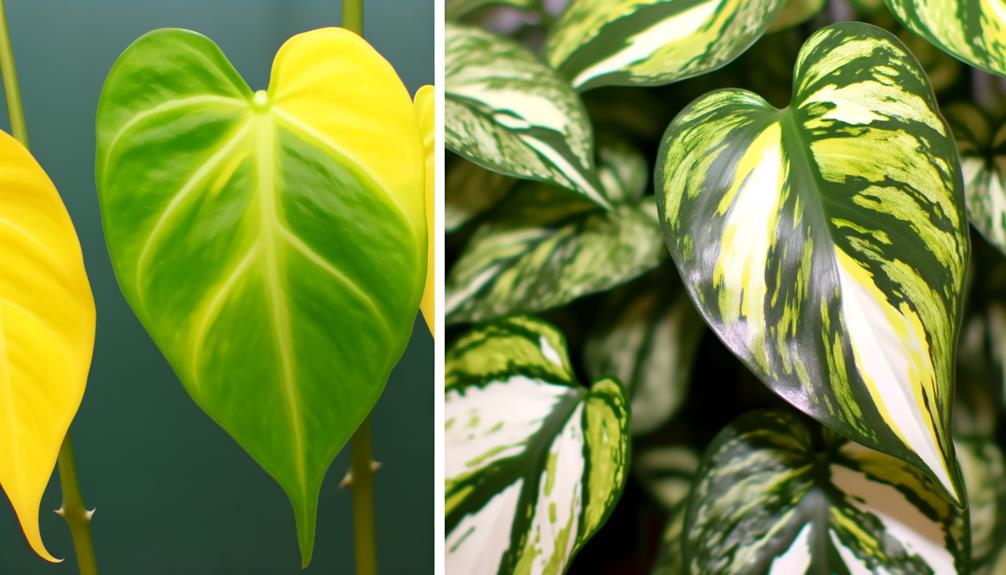
Color and variegation in Philodendron Brasil and Pothos are distinct and provide significant insights into their botanical characteristics and aesthetic appeal.
Philodendron Brasil features striking variegation with lime-green streaks that contrast against a darker green backdrop, creating a vivid, almost painted appearance. This variegation is typically irregular, adding to its visual intrigue.
In contrast, Pothos, particularly the Golden Pothos variety, displays more uniform variegation with splashes of creamy yellow or white interspersed among the green. The intensity and pattern of variegation in Pothos can vary with light conditions, making it a dynamic addition to any setting.
Both plants manifest variegation through differential chlorophyll distribution, impacting not only their appearance but also their photosynthetic efficiency and light requirements.
Growth Patterns
When examining the growth patterns of Philodendron Brasil and Pothos, notable differences emerge in vine length, leaf shape, and their respective climbing versus trailing behaviors.
Philodendron Brasil typically exhibits shorter, more compact vines with heart-shaped leaves, favoring a climbing habit that utilizes aerial roots for support.
In contrast, Pothos, with its longer vines and more ovate leaves, tends to thrive in both climbing and trailing environments, showcasing its versatility in adapting to various growth conditions.
Vine Length Differences
The growth patterns of vine length between Philodendron Brasil and Pothos exhibit distinct differences, primarily influenced by their respective genetic traits and environmental adaptations.
Philodendron Brasil tends to produce shorter, more compact vines, often reaching lengths of up to 8-10 feet under ideal conditions. This is partly due to its native habitat in tropical rainforests where support structures abound.
In contrast, Pothos, or Epipremnum aureum, can develop considerably longer vines, sometimes extending to 20-30 feet when given ample space and suitable conditions. The elongation of Pothos vines is an adaptive trait, enabling it to efficiently cover large areas in its native environments.
These differences in vine length underscore the unique evolutionary strategies each plant employs for survival and propagation.
Climbing Vs. Trailing
Distinct growth patterns distinguish Philodendron Brasil and Pothos, with the former showing a climbing tendency facilitated by aerial roots and the latter mainly exhibiting a trailing habit that allows for extensive horizontal spread.
Philodendron Brasil’s aerial roots enable it to attach to vertical supports, making it well-suited for vertical gardening or trellises. In contrast, Pothos thrives in conditions where it can cascade downwards, making it suitable for hanging baskets or ground cover.
| Characteristic | Philodendron Brasil | Pothos |
|---|---|---|
| Growth Pattern | Climbing | Trailing |
| Root Type | Aerial Roots | Adventitious Roots |
| Ideal Use | Vertical Supports, Poles | Hanging Baskets, Ground |
Understanding these distinct growth tendencies allows for the best placement in horticultural designs, enhancing both aesthetic appeal and plant health.
Light Requirements
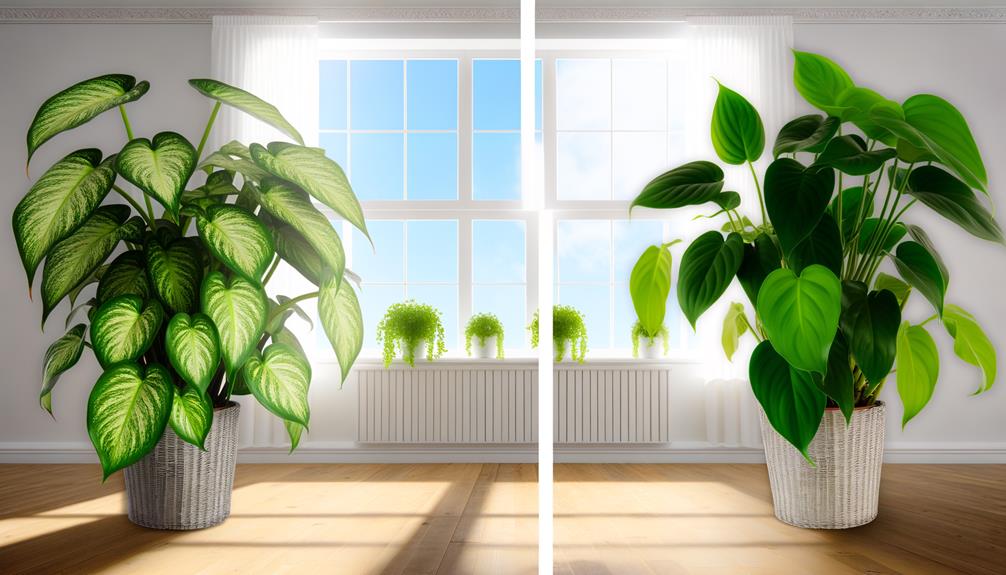
Philodendron Brasil and Pothos both thrive in bright, indirect light, but each plant exhibits varying degrees of tolerance to lower light conditions.
Philodendron Brasil displays a moderate adaptability to lower light environments, maintaining its variegated foliage with minimal light loss, though best growth occurs with ample, diffused sunlight.
Pothos, conversely, demonstrates greater resilience in low-light scenarios, often retaining its vibrancy and trailing growth even under fluorescent lighting. Nonetheless, both species benefit from avoiding direct sunlight, which can cause leaf scorch and discoloration.
The chlorophyll concentration in their leaves accounts for these varying light tolerances, influencing photosynthetic efficiency and growth dynamics. Therefore, understanding these requirements promotes optimal plant health and longevity for both species in diverse indoor settings.
Watering Needs
While light requirements play an essential role in the growth of Philodendron Brasil and Pothos, their watering needs are equally important in ensuring robust health and development.
Philodendron Brasil prefers consistently moist soil, yet it is susceptible to root rot if overwatered. Consequently, allowing the top inch of soil to dry out between waterings is advisable.
Conversely, Pothos, known for its hardiness, thrives with less frequent watering. It tolerates drier conditions, and its soil should be allowed to dry out more thoroughly between waterings. Overwatering Pothos can lead to root rot and yellowing leaves.
Both species benefit from well-draining pots and vigilant observation to adjust watering schedules based on environmental factors like humidity and temperature.
Soil Preferences
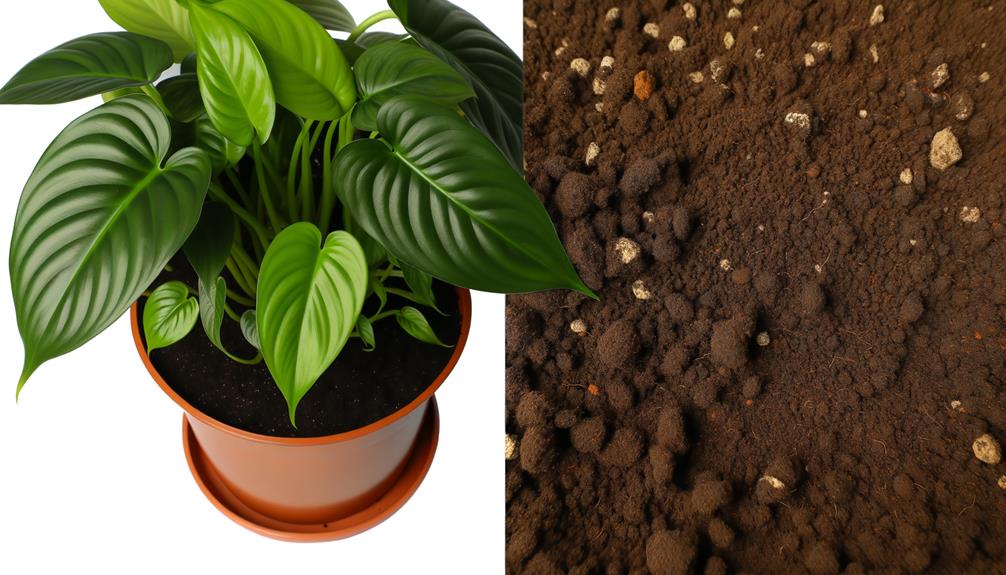
Both Philodendron Brasil and Pothos display ideal growth in well-draining soil mixtures that prevent waterlogging and promote sufficient aeration for their root systems. A mix of peat moss, perlite, and pine bark is recommended for these species, as it retains moisture without becoming excessively saturated.
The organic material in peat moss improves nutrient retention, while perlite offers essential aeration and drainage. Pine bark helps maintain the structural strength of the medium, preventing compaction. This combination establishes an excellent environment for root development and reduces the risk of root rot.
Regularly evaluating the soil composition is essential; adjustments may be needed to maintain the balance of moisture and aeration, ensuring the plants’ continual health and vitality.
Temperature and Humidity
Best growth for Philodendron Brasil and Pothos is achieved in environments where temperature ranges from 65°F to 80°F, paired with humidity levels between 60% and 80%.
These conditions closely resemble their native tropical habitats, promoting ideal physiological processes such as photosynthesis and transpiration. High humidity is especially important, as it prevents the drying out of foliage and supports strong leaf development.
In lower humidity environments, these plants may show slower growth and increased vulnerability to pest infestations. Temperature fluctuations outside the specified range can cause metabolic stress, leading to stunted growth or leaf drop.
Maintaining stable, warm, and humid conditions is essential for ensuring the health and visual appeal of both Philodendron Brasil and Pothos.
Toxicity to Pets
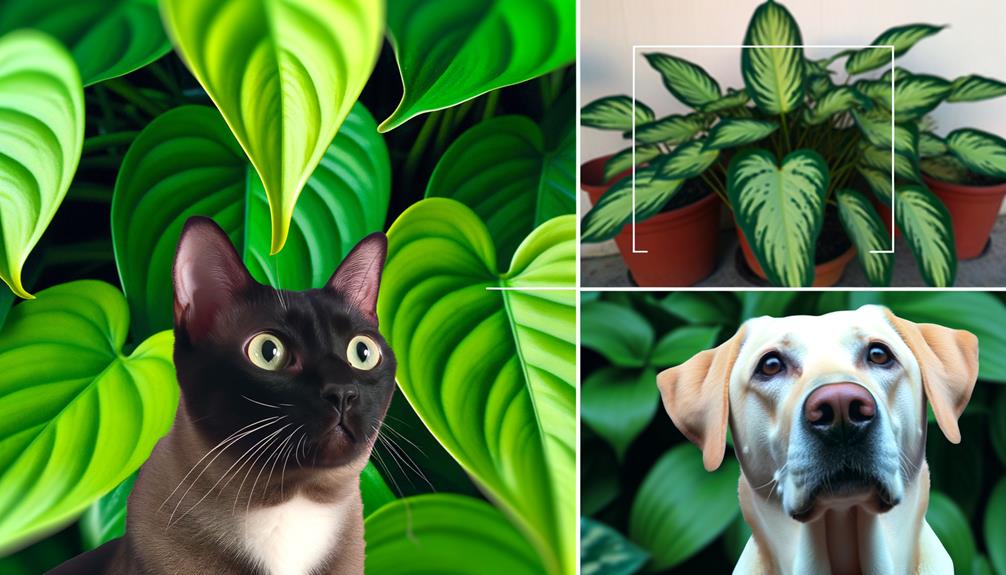
Philodendron Brasil and Pothos are both known to be toxic to pets due to the presence of insoluble calcium oxalate crystals in their foliage. These tiny, needle-like crystals can cause severe irritation upon ingestion, leading to symptoms such as drooling, oral swelling, vomiting, and difficulty swallowing.
When a pet chews on the leaves, the crystals penetrate the mucous membranes of the mouth and throat, producing an immediate burning sensation. While not usually fatal, ingestion warrants prompt veterinary evaluation to manage symptoms and prevent complications.
Pet owners should exercise caution by placing these plants out of reach or opting for non-toxic alternatives to ensure the safety of their animals.
Propagation Techniques
Propagation of Philodendron Brasil and Pothos primarily involves the use of stem cuttings. This method leverages the plants’ natural ability to form roots at nodes along the stem. For best results, select a healthy stem with at least one node and a couple of leaves. Using a sterilized cutting tool, make a clean cut just below a node.
The cuttings can be rooted in either water or soil. When using water, make sure the node is submerged while leaves remain above the surface. In soil, plant the node directly in a well-draining medium. Maintain high humidity and indirect light to promote root development.
Observing these steps carefully will yield successful propagation.
Common Pests and Diseases
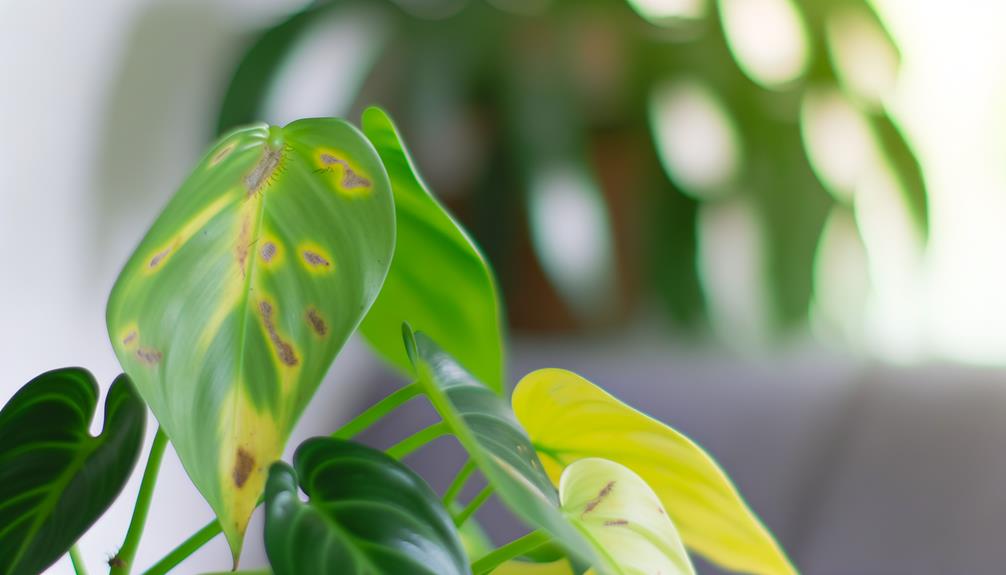
In addition to mastering propagation techniques, it is essential to understand the common pests and diseases that can affect Philodendron Brasil and Pothos, as these issues can greatly impact plant health and growth.
Philodendron Brasil is particularly susceptible to spider mites and aphids, which can be managed through regular inspection and appropriate insecticidal treatments.
Pothos, on the other hand, often encounters problems with mealybugs and scale insects.
Both plants are vulnerable to root rot, typically caused by overwatering and poor drainage, necessitating careful watering practices and well-draining soil.
Fungal infections, such as leaf spot and blight, can also pose risks, highlighting the importance of maintaining ideal humidity levels and ensuring good air circulation around the plants.
Ideal Uses in Home Decor
When considering Philodendron Brasil and Pothos for home decor, their versatile hanging options make them ideal for creating vertical green spaces.
Both species excel as statement pieces on shelves, where their cascading foliage can be effectively showcased.
Additionally, their adaptability to low-light conditions makes them suitable for brightening dim corners, thereby enhancing the overall aesthetic and ambiance of interior spaces.
Versatile Hanging Options
Both Philodendron Brasil and Pothos offer exceptional versatility for hanging installations, making them ideal candidates for enhancing vertical spaces in home decor. Their trailing vines create a dynamic visual effect, adding depth and greenery to any room.
Philodendron Brasil, with its variegated leaves, brings a vibrant aesthetic, while the Pothos, known for its hardy nature, offers a more uniform green hue. These species thrive in indirect light and adapt well to various humidity levels, making them suitable for most indoor environments.
Additionally, their ability to purify the air adds functional value beyond mere decoration. When suspended in hanging baskets or mounted on walls, they can transform mundane spaces into lush, inviting sanctuaries.
Statement Shelf Decor
Philodendron Brasil’s variegated leaves and Pothos’ lush green vines both serve as striking elements for statement shelf decor, providing a sophisticated botanical touch to enhance any room’s aesthetic. Their distinct morphology and growth patterns make them ideal for a range of decorative applications, creating dynamic visual interest.
Consider the following placements:
- Solo Display: A single plant in an elegant pot can serve as a focal point, highlighting its unique foliage.
- Clustered Arrangement: Grouping with other plants enhances textural contrast and visual depth.
- Trailing Over Edges: Allowing vines to cascade off the shelf edges adds a natural, flowing element.
- Vertical Shelving: Utilizing vertical space accentuates the plant’s growth habit, making the room appear taller and more vibrant.
These methods utilize the plants’ intrinsic beauty to elevate interior decor effectively.
Low-Light Corners
In low-light corners, the adaptability of Philodendron Brasil and Pothos to suboptimal lighting conditions makes them ideal candidates for enhancing underutilized spaces within home decor. Both plants exhibit a high degree of photosynthetic efficiency even under limited light, a trait attributable to their native tropical habitats.
Philodendron Brasil, with its variegated foliage, adds visual interest and a touch of color, while Pothos, known for its vigorous growth, can cascade gracefully, creating a lush, verdant ambiance. Scientific studies indicate that these species can tolerate low light by adjusting their chlorophyll concentration and leaf morphology, optimizing light capture.
Consequently, they not only thrive but also improve air quality, making them functional as well as aesthetically pleasing houseplants for dimly lit areas.
Is Philodendron Brasil A Pothos
No, Philodendron Brasil is not a Pothos. While both plants are often confused due to their similar appearance and care requirements, they belong to different genera within the Araceae family.
- Philodendron Brasil (Philodendron hederaceum ‘Brasil’): This plant is known for its heart-shaped leaves with striking variegation of green and yellow. It is a cultivar of the Heartleaf Philodendron and is a trailing or climbing vine, making it a popular choice for hanging baskets or as a climbing plant on a support.
- Pothos (Epipremnum aureum): Often called Devil’s Ivy, Pothos has similar trailing or climbing growth habits and heart-shaped leaves but belongs to a different genus. Pothos leaves also exhibit various patterns and colors, such as green, yellow, white, and even neon green.
Despite their similarities in appearance and care (both preferring bright, indirect light and well-draining soil), they are distinct species with different botanical classifications.
Conclusion
In comparing Philodendron Brasil and Pothos, these botanical marvels exhibit distinct differences in origin, morphology, and cultivation needs.
Philodendron Brasil, with its heart-shaped leaves and vibrant variegation, contrasts with the waxier, more elongated foliage of Pothos.
Each species thrives under specific light conditions and presents unique propagation challenges. Both, however, share a shadow of toxicity to pets.
In the tapestry of home decor, they serve as living threads, weaving elegance and greenery into the domestic landscape.

